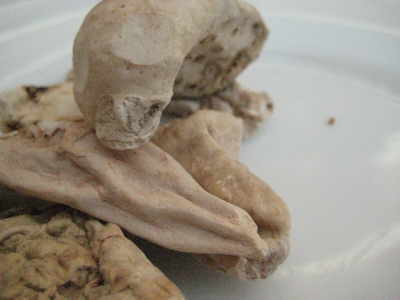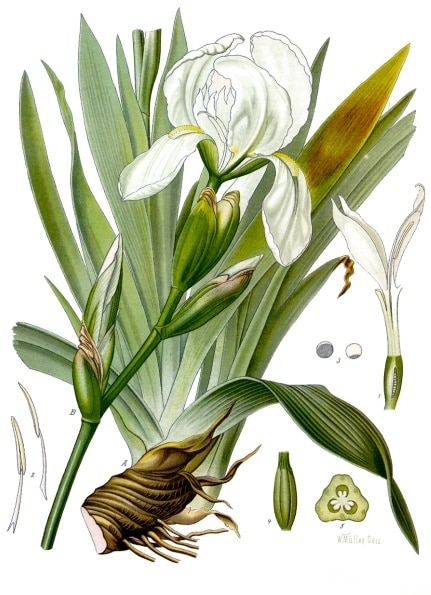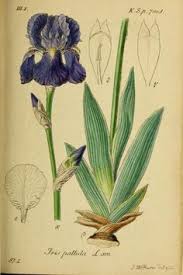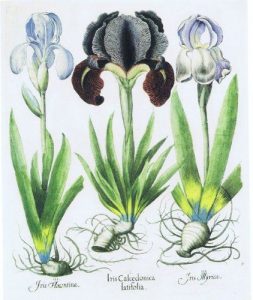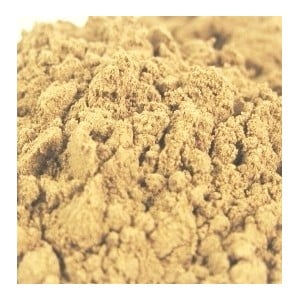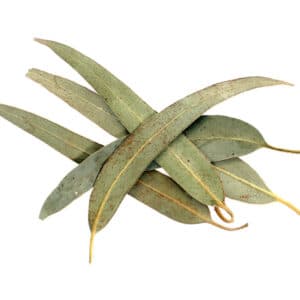Orris Root Whole – Iris florentina
£14.50
Whole Orris Root
Iris germanica, Iris florentina, and Iris pattida
Also known as Iris, Flag Iris, Pale Iris, and Orris Butter
50 grams
Orris Root (Iris germanica, Iris florentina, and Iris pattida) is a perennial plant with sword-shaped leaves and highly scented, pale blue flowers. The fleshy rootstock (rhizomes) grow just below and along the ground. The rhizomes are dug up in August and freed of the rootlets and brown outer bark, and then they are dried.
The whole dried Orris Root is incredibly hard and doesn’t always have a strong aroma until shaved or grated. Ours is quite aromatic.Rather than attempt to grind it yourself – It will ruin your grinder, if you are using Orris as a fixative in Pot Pourri you would be better off using the ready ground fine powder.
Also known as Iris, Flag Iris, Pale Iris, and Orris Butter
Orris Root is a fixative used in potpourri for its colour and its scent, which is similar to Violets. Most commercial orris is produced in Italy where it grows wild.
Traditional Uses of Orris Root:-
Orris Root is a fixative used in potpourri and the oil from which it derives is used in perfume for its colour and its scent, which is similar to Violets. Most commercial orris is produced in Italy where it grows wild (which is where ours comes from, collected from the wild using sustainable 1:20 collection methods)
The root can be used as flavouring in sweets, and as a base for toothpastes and perfume where in particular it is used as a fixative. For use in perfume it must be “hung” for at least 5 years before it can be used.
Orris Root tea was used to treat bronchitis, colds, coughs, diarrhoea, and dropsy. It is still used to strengthen gums and freshen breath. The Root has diuretic, emetic, and cathartic properties. It can also be used for colic and liver congestion.
 History of Orris Root:-
History of Orris Root:-
In ancient Greece and Rome, Orris Root was largely used in perfumery, and Macedonia, Elis and Corinth were famous for their unguents of Iris.
Theophrastus and Dioscorides were well acquainted with Orris Root; Dioscorides and Pliny remark that the best comes from Illyricum (now modern Dalmatia). Probably I. Germanica is the Illyrian Iris of the ancients, as it is plentiful there and I. Florentina and I. pallida do not occur. The latter were probably introduced into Northern Italy in the early Middle Ages.
The ancient arms of Florence – a white Lily or Iris on a red shield – seem to indicate that the city was famed for the growth of these plants.
A writer of the thirteenth century, Petrus de Crescentiro of Bologna, mentions the cultivation of the White, as well as of the Purple Iris, and states at what season the root should be collected for medicinal use.
In Hoodoo and in spiritual uses it is known as the “Love Drawing Herb” and “Queen Elizabeth Root” and is used to ensnare and guarantee the love of someone in return for the earnest love of the one casting the spell.
For those wanting Orris Root in Fine Powdered Form click here….
| batch-code | |
|---|---|
| country-of-origin |
